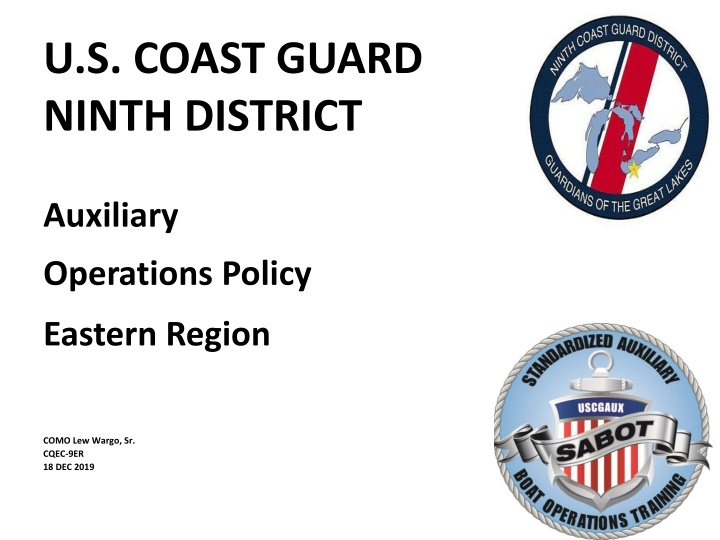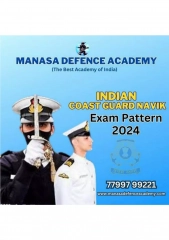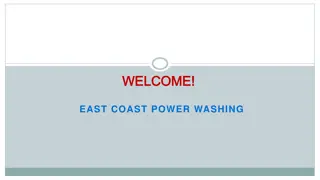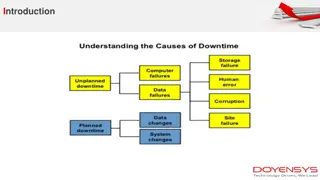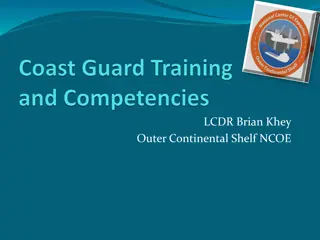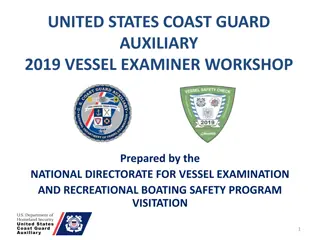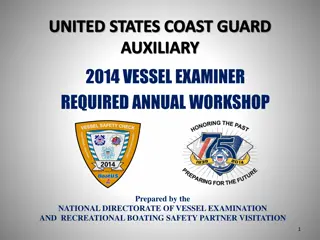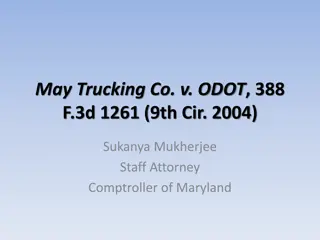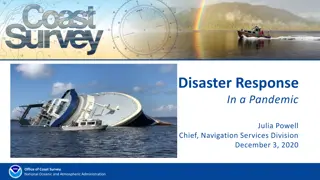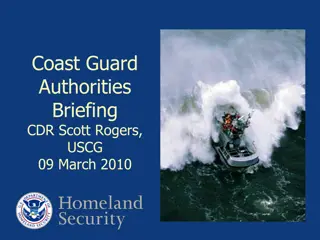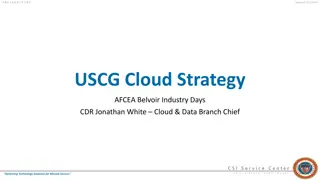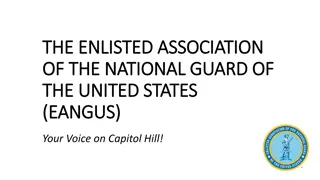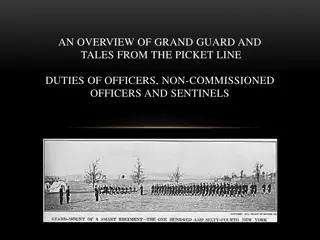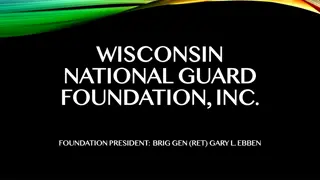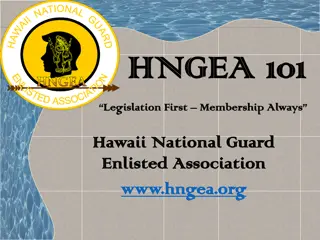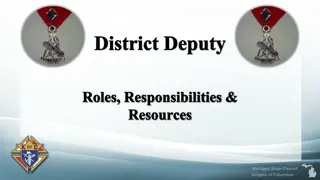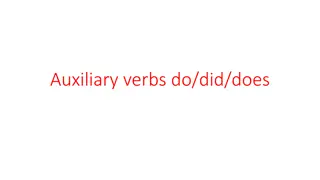U.S. Coast Guard Ninth District Auxiliary Operations Policy
This document outlines the operations policy of the U.S. Coast Guard Ninth District Auxiliary for the Eastern Region, covering aspects such as missions, SAR ethos, entry into Canadian territory, SAR mission coordinator duties, on-scene coordinator responsibilities, and risk assessment protocols.
Download Presentation

Please find below an Image/Link to download the presentation.
The content on the website is provided AS IS for your information and personal use only. It may not be sold, licensed, or shared on other websites without obtaining consent from the author.If you encounter any issues during the download, it is possible that the publisher has removed the file from their server.
You are allowed to download the files provided on this website for personal or commercial use, subject to the condition that they are used lawfully. All files are the property of their respective owners.
The content on the website is provided AS IS for your information and personal use only. It may not be sold, licensed, or shared on other websites without obtaining consent from the author.
E N D
Presentation Transcript
U.S. COAST GUARD NINTH DISTRICT Auxiliary Operations Policy Eastern Region COMO Lew Wargo, Sr. CQEC-9ER 18 DEC 2019
REFERENCES COAST GUARD ADDENDUM TO THE NATIONAL SAR AND RESCUE SUPPLEMENT (NSS) OF THE (IAMSAR), COMDTINST M16130.2(series) AUXILIARY OPERATIONS POLICY MANUAL COMDTINST M16798.3(series) RESCUE AND SURVIVAL SYSTEMS MANUAL, CMDINST M10470.10(series) NINTH DISTRICT INSTRUCTION: M16100.1(series)
MISSIONS Auxiliary facilities on patrol should always be ready for: Distress or assistance calls; even when ordered to stand by at a pier.
MISSIONS Auxiliary facilities may be used for: SAR Call-Outs Safety patrols Marine Observation Missions Regattas Parades ATON checks Marine Safety
D9 SAR ETHOS The CGD Nine SAR Responders should treat every potential victim as one of our own family.
ENTRY INTO CANADIAN TERRITORY In accordance with parts 3.6 and 3.7 of Annex I, permission for Coast Guard assets to enter the Territory of Canada for SAR purposes is not always mandatory, but prompt notification of such activity to the Ninth District Command Center is required. In turn, the Ninth District Command Center will notify the Appropriate Canadian authorities.
SAR MISSION COORDINATOR The SAR Mission Coordinator (SMC) duties in 9ER are handled by Sector Buffalo. The District SAR Coordinator shall assume SMC when: 1. Involves more than 1 Sector. 2. When using DOD, Canadian or District resources. 3. If in Canadian waters. 4. Involves merchant ships 5. Extended cases or politically sensitive cases.
ON SCENE COORDINATOR The On Scene Coordinator (OSC) should be the most capable facility available, taking into consideration: SAR training Communication capabilities Length of time that the facility can stay in the search area.
ON SCENE COORDINATOR All elements of the SAR response are responsible for an accurate risk assessment. The GAR II model is the required method for measuring the risk assessment for SRUs. That is: RISK vs Gain .
SRU DEPLOYMENT The deployment of any boat is at the discretion of the station commanding officer or officer-in-charge. Auxiliary facilities will not be operated in surf. Surf is defined as any series of breakers in continuous line regardless of wave height or proximity to shore.
D9 MINIMUM CREW REQUIREMENTS Boats <30 w/cabin:1 coxswain, 2 crew All others see Auxiliary requirements: =>26 <40 : 1 coxswain, 2 crew =>40 <65 : 1 coxswain, 3 crew =>65 : 1 coxswain, 4 crew Sector Commanders may deviate but must notify d9. Ref: AUX OPS POLICY page 1-31 and d9 Instruction M16100.1(series) page 2-5
COXSWAIN RESPONSIBILITIES Know the patrol area Verify that fuel tanks are full at the start of a patrol and all equipment is functioning. Ensure that the crew is certified, capable of performing the mission, being in the proper uniform and having the required PPE gear. Verify that at least one other crew member is qualified to operate the boat in case the coxswain needs to seek relief.
COXSWAIN RESPONSIBILITIES Provide a thorough briefing on the boat, its equipment and operation. Stress safety, any known hazards, risk management and situational awareness. Notify the Operational Commander when ready to get underway and pass along status as to Risk Assessment, number of POBs, your intent as to AOR, etc.
COXSWAIN RESPONSIBILITIES Maintain a 2-way communication with the Operational Commander. If unable to contact use an alternate shore unit, (Auxiliary, or federal, state or local unit) for the radio guard and to reach the Operational Commander. If this link is lost for a reasonable period of time, the mission must be aborted.
COXSWAIN RESPONSIBILITIES Operations/Position Reports shall be transmitted every 30 minutes under normal operating conditions (fair weather/routine patrol) and every 15 minutes under the following conditions: * Foul Weather * Reduced visibility or darkness * If water temperature is below 50 * Other circumstances as directed
COXSWAIN RESPONSIBILITIES Whenever an Auxiliary Facility deviates from the Intended sorties operating area for any reason they must notify the operational commander (watchstander at the station) of the change.
COXSWAIN RESPONSIBILITIES Keep the Operational Commander informed of all your activity including the rendering of assistance for a Come-Upon . Report and keep a log of all activity including ATON discrepancies, boating traffic, special events, changes to weather conditions, disabled vessels requesting assistance, any environmental issues, etc.
COXSWAIN RESPONSIBILITIES Monitor sea and weather conditions and if they exceed the facilities or crew s limitations the mission should be aborted or the assigned AOR changed to a safer area.
COXSWAIN RESPONSIBILITIES In the event of a sudden storm, pleasure boaters may need assistance. While the coxswain should never jeopardize the safety of the crew, it is important to render assistance if it is safe to do so. Established Operational limitations should never be exceeded. See Auxiliary Operations Policy Manual, COMDTINST M16798.3(series), 1.I.6 and Ninth District Instruction, M16100.1(series) Appendix 5, Annex J .
COXSWAIN RESPONSIBILITIES When starting a patrol, there should be a complete sweepof the assigned AOR. When a patrol in an adjacent area is tied up, consider moving closer to the other AOR. At the end of a patrol, get permission from the appropriate Coast Guard authority to secure. If possible make a final sweep of the assigned AOR before securing.
ASSISTANCE POLICY A. While under orders and you Come Upon a disabled vessel that has not yet called for assistance, you may undertake to assist, (including towing) if it is within your capability. See COMDTINST M16130.2(series), 4.1.6.4. You should always advise the Operational Commander before starting to render such assistance in the event they have a higher priority mission for you.
ASSISTANCE POLICY B. Coast Guard resources (including Auxiliary) may be used to help Auxiliary facilities at any time! See NSS, COMDTINST M16130.2 (series), 4.1.5.8. c. Immediate response shall be initiated, if feasible, to any known situation in which the mariner is in imminent danger. This response may be provided by active duty CG, Auxiliary, or other entities.
ASSISTANCE POLICY E. Non-distress cases: When specifically requested assistance, such as a commercial firm, marina, or friend, is not available, a request for assistance will be broadcasted by the CG unit or command (MARB). When a commercial provider is available in a reasonable period of time (usually one hour), or an offer of assistance is made by any responder, no other action is required other than to monitor the incident. Otherwise an Auxiliary facility, if available may be used with permission of the Sector.
ASSISTANCE POLICY F. Non-distress use of the Coast Guard: The CG supports and encourages efforts of private enterprise and volunteerism to assist mariners. CG resources will not unnecessarily interfere in non-distress cases. If alternate assistance is not available after a MARB, a CG resource (including an Auxiliary Facility) may assist when no higher priority exists and no other capable resource is available in a reasonable period of time. This requires permission from the Sector. See COMDTINST M16130.2 (series), 4.1.6.4
ASSISTANCE POLICY G. If a CG resource finds another responder on scene whose assistance is not adequate, the CG resource should immediately attempt to stabilize the emergency. Once stabilized, the resource may be withdrawn if the first responder appears capable and is willing to conclude the case. The CG resource should not normally be withdrawn if continued stability of the situation is dependent on CG equipment or expertise. See COMDTINST M16130.2(series), 4.1.6.2 (c).
ASSISTANCE POLICY H. Safe Haven: In cases involving towing, the CG or Auxiliary is only obligated to take the vessel to the nearest safe haven. A Safe Haven is a mooring willing to accept the disabled and has a telephone for their use. See COMDTINST M16130.2(series), 4.1.6.5.
ASSISTANCE POLICY I. Unmanned/Adrift (U/A) vessels could be an indicator of possible distress. The first SRU shall immediately look for signs of distress (or lack there of) including debris in the water, position of the motor and controls, mooring lines, bilge water, foot prints, electronic settings, etc. Also look for registration, HIN number, etc. If a search is started the preferred pattern is the SS with a track spacing of .1 NM.
ASSISTANCE POLICY J. Adrift lifejackets and life rings are also a potential sign of distress, but usually have less information with them. Report the finding to the operational commander and If there is no other signs of distress, the minimum response shall be the same as for an unmanned/adrift vessel ( SS search pattern with a .1 NM track space).
AUXILIARY FACILITIES A. Must be offered for use and accepted by the Director of Auxiliary or designee. B. The OFU form must include a complete description of the facility describing the characteristics of the facility, a list of all equipment onboard and include the Facility Inspection (back of form). Included must be the limitations of the facility as to conditions in which it can operate safely and effectively. See COMDTINST M16798.3 (series), 1.H.7 and 1.I.6.
AUXILIARY FACILITIES D. Facility Offer-for-Use is good for one year, plus 45 days from the date of acceptance. E. All current Auxiliary facilities must display their Facility decal on the vessel. If the vessel is sold, this decal must be removed. F. All facilities must be maintained in good working condition. G. Missions should be aborted when situations pertaining to the facility or crew may adversely affect the safety of the mission.
AUXILIARY OPERATORS A. Ordersmust be obtained and be onboard (except for verbal and call-outs). B. Orders must be obtained via the on-line AOMS (Auxiliary Order Management System). C. Ensure that the crew is capable of performing the mission and are in the proper uniform with all required PPE gear attached.
AUXILIARY OPERATORS FATIGUE STANDARDS D. Operate within crew fatigue guidelines, See COMDTINST M16798.3(series), 4.E.8: TYPE BOAT AUX < 30 AUX > 30 SEAS<4 8 Hours 8 Hours SEAS>4 --------- 6 Hours REST 8 Hours 8 Hours
AUXILIARY OPERATORS E. Facility operators shall assume responsibility for supervising and safely carrying out the ordered mission in accordance with current CG policy and principals of risk management.
AUXILIARY OFFICERS A. Auxiliary elected and appointed staff officers for operations have the overall responsibility of managing the Auxiliary Operation Program. B. Operations and Member Training staff officers and unit elected leaders have the responsibility and authority to abort any ordered mission. This is to be done in the event they become aware of any situation pertaining to the facility or crew that may effect the safety of the mission.
AUXILIARY CREWS A. There are no physical standards for participating in Auxiliary Surface Operations. However, each must demonstrate the ability to complete all tasks in the Auxiliary Boat Crew Qualification program and be able to demonstrate the mobility and endurance necessary to perform in a challenging and stressful environment.
AUXILIARY CREWS B. All coxswains, crew and PWOs must be certified in accordance with the Auxiliary Boat Crew Qualification Program. To remain certified they must: 1. Pass a QE check-ride every 3 years. 2. Complete a 4 hour TCT course every 5 years and take a 1 hour annual TCT refresher course. 3. Coxswains and PWOs must pass an on-line NAV-RULES exam every 5 years.
AUXILIARY CREWS C. Auxiliary members may volunteer to downgrade from coxswain to crew by notifying DIRAUX or the OTO in writing. However, the downgraded member must meet all of the requirements for crew including a QE check-ride and TCT.
AUXILIARY CREWS D. Auxiliary surface facilities must meet the minimum crew requirements below: FAC LENGTH COX < 26 * 1 >=26 <40 1 >=40 <65 1 >65 1 These are minimums. Encourage having more. CREW 1* 2 3 4 * Requires 1 coxswain and 2 crew for SAR if facility has a cabin.
AUXILIARY CREWS E. Order Issuing Authorities, (OIA) may add to crew requirements as well as equipment on a facility. Ninth district requires 1 coxswain and 2 crew to perform SAR with a facility under 30 feet that has a cabin.
PATROL ORDERS A. Auxiliarists may not use any facility or special purpose facility for any CG or CG Auxiliary purpose or mission unless appropriate patrol orders have been issued and the facility has been accepted for use. B. Patrol orders do not guarantee liability coverage. See NOTE in CMDTINST M16798.3 (series), Chapter 2.A. C. OIAs may only issue orders to operators who will be in charge of an ordered mission.
PATROLS ORDERS D. Orders must not exceed known capabilities, and must not go beyond the scope of Auxiliary duties. E. An Auxiliarist is not required to accept orders. F. Completed or aborted missions are officially terminated upon return to point of departure. Patrol orders for completed missions remain in effect until return to the point of origin.
PATROLS ORDERS G. Verbal orders may be issued in emergencies and when necessary, non-emergencies. These are issued by a CG OIA. H. Expenses: If authorized, reimbursement for a patrol may include the actual necessary expenses of operation (e.g., payment of fuel, oil, landing or ramp fees, subsistence, and ice, etc.). When trailering a facility, vehicle fuel, tolls, ramp ,hoist fees, and park entrance fees may also be reimbursed.
PATROLS ORDERS I. Claims for reimbursement must be submitted within 3 days(per the Order Management System) after completing the mission. (Retain a copies of receipts) II. Contingency orders are issued to coxswains who may discover SAR situations while not assigned to duty and not in contact with the unit commander (OIA). These will be followed up with written orders after completing such a SAR case.
PATROL ORDERS I. SAMA (Standardized Maintenance Allowance) payments may be paid to a facility owner (depending on fund availability) based on size, power and hours of use on a surface facility. The intent of this is to assist the member-owner with the maintenance of the facility.
MISHAP REPORTING A. An individual or unit with first hand knowledge of an accident or incident while assigned to duty MUST report all available information in accordance with district requirements. This includes notifying the OIA, and completing a MISHAP report. A damage claim may also be initiated. In the event of injury, take care of The injured first.
MISHAP REPORTING B. Damage claim procedures include the following: Immediate report of loss or damage Insurance company involvement Claim submission Claim investigation No action to repair shall be taken until the CG has completed its investigation. The Insurance company should also be notified in the event the claim is rejected.
MISHAP REPORTING C. The Coast Guard OIA shall investigate all claims in accordance with MLC guidelines. The OIA does not have to investigate minor claims under $200. Payment for minor claims may be authorized by the OIA and paid out of the OIA s normal operating expenses. All damage claims must be linked to some identifiable patrol cause during an ordered mission.
MISHAP REPORTING D. When there is a catastrophic failure to an Auxiliary facility, where the facility is damaged by reason of its use, such a claim may be payable for repair and replacement of the facility or equipment subject to the availability of funds. An Auxiliarist must maintain a facility log book documenting personal and CG) use. The log must be in a bound book. Loose leaf is not acceptable.
MISHAP REPORTING E. Claims are not payable if it is the result of gross negligence or willful misconduct of the claimant. F. Auxiliarists must to the best extent possible, reduce the risk of loss or damage to personal property by removing all personal property from an Auxiliary facility while assigned to duty. G. Personal injury while assigned to duty should be reported to the OIA and DIRAUX (via the chain of leadership) immediately and seek proper medical attention.
MISHAP REPORTING H. Third party claims against the CG, the Auxiliary, or an individual Auxiliarist from an incident occurring while assigned to duty will be defended by the U.S. Government. Members must keep accurate written records of any such incident. Record names of witnesses, get photographs, and statements to the extent possible.
